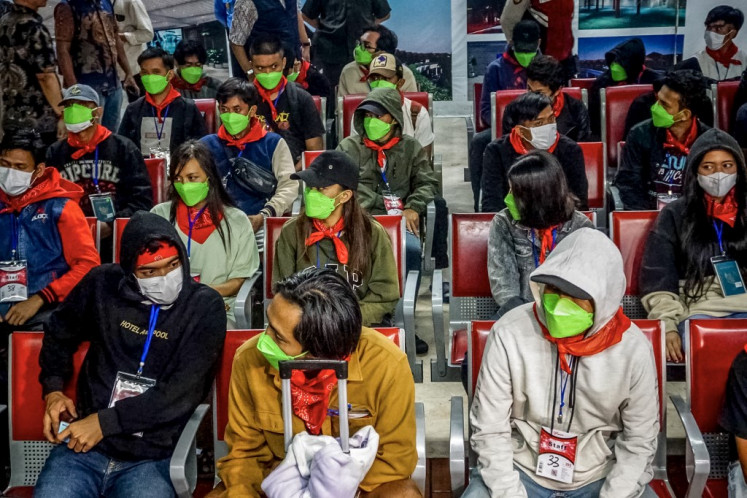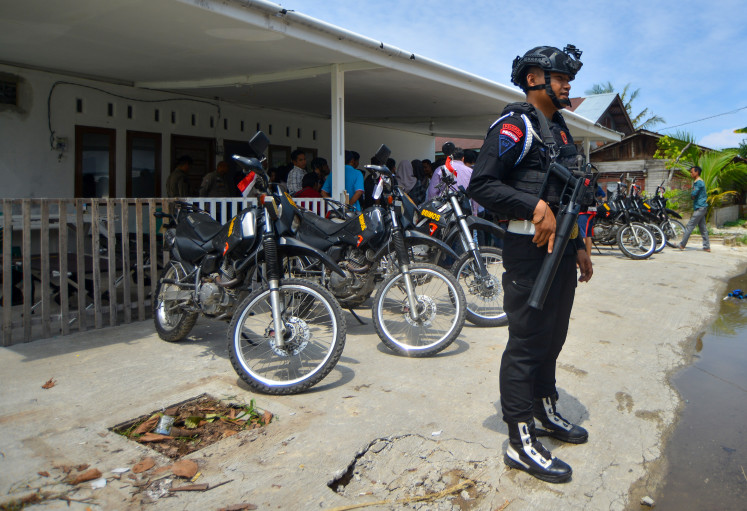Popular Reads
Top Results
Can't find what you're looking for?
View all search resultsPopular Reads
Top Results
Can't find what you're looking for?
View all search resultsLack of infrastructure holds back airline performance
Operators say that a lack of infrastructure remains a major obstacle to development in Indonesia’s aviation sector as airports across the country, even the capital city’s Soekarno-Hatta International Airport, are too small to accommodate demand
Change text size
Gift Premium Articles
to Anyone
O
perators say that a lack of infrastructure remains a major obstacle to development in Indonesia’s aviation sector as airports across the country, even the capital city’s Soekarno-Hatta International Airport, are too small to accommodate demand.
Major airports in the country such as Jakarta’s Soekarno-Hatta airport, Surabaya’s Juanda International Airport and Makassar’s Sultan Hasanuddin International Airport are operating at around 200 to 300 percent beyond capacity.
National flag carrier Garuda Indonesia’s vice president for communications, Pujobroto, said that this issue caused inevitable flight delays and increased aircraft waiting times from taxiway to runway to more than 10 minutes.
“It occurs especially during peak morning hours from 6 a.m. to 10 a.m., and in the afternoon from 4 p.m. to 7 p.m.,” Pujobroto said.
Garuda’s average on-time performance fell from 85.46 percent in 2011 to 84.96 percent last year, according to recent data from the Transportation Ministry.
“The airline sector grows at one-and-a-half or even two times faster than economic growth in Indonesia. This means higher demand for airline travel, which should be supported by infrastructure development,” Pujobroto said.
Through the firm’s Quantum Leap program, Garuda’s flight traffic will be increasing from its current 400 flights a day to 1,200 flights a day by the end of 2015. The airline, however, needs adequate infrastructure to ensure their services run smoothly.
Many of the additional flights will be centered on eastern Indonesia. To accommodate growth, Garuda has signed an agreement with all the governors in Sulawesi to help accelerate airport and human resource development on the island.
Makassar’s Sultan Hasanuddin International Airport is Garuda’s hub and planes fly from Jakarta more than 20 times a day. State-owned airport operator Angkasa Pura I (AP I), which oversees airports in the country’s eastern regions, is expanding the airport, including its apron so that by 2015, 62 aircraft will be able to be parked on it at any one time from the current capacity for 31 aircraft.
Garuda, Pujobroto went on, also hoped that Angkasa Pura II (AP II), which oversees airports in the western half of Indonesia, would accelerate the expansion of Soekarno-Hatta airport as the airline was preparing to build a special lounge to mark its planned alliance with international airline network Sky Team next year. Sky Team currently has 19 member airlines, including Air France, KLM, Delta, Vietnam Airlines, Korean Air and AeroMexico.
Lion Air’s general affairs director, Edward Sirait, also said that poor aviation infrastructure had become domestic airlines’ primary concern, especially at those times when a destination city was hosting a major national or international event.
“Major events that attract VIPs can affect all the operations in the respective airport. For scheduled airlines, this can spell disaster because our flight schedules are changed and sometimes we have to wait several hours for [a new schedule],” Edward said, adding that Bali was one of the most popular locations for high-profile events, affecting schedules at the island’s Ngurah Rai International Airport.
He said a Lion Air Jakarta–Denpasar flight had once been diverted to Surabaya, East Java, and Yogyakarta because Ngurah Rai could not accept more flights at the time, which resulted in passengers growing impatient and angry. “Situations like that are difficult because we can’t do anything,” he continued.
Poor infrastructure also affects air slots, especially at Soekarno-Hatta airport, keeping airlines from expanding their networks.Citilink Indonesia’s vice president for communications and marketing, Aristo Kristandyo, said they had been prevented from running the Batam-Jakarta route because of airport-slot congestion. “We still want to connect Batam with Jakarta, but we have to stop over in Padang [West Sumatra],” Aristo said.
In addition, runways at major airports like Juanda International Airport in Surabaya, East Java, and Ngurah Rai airport have been trying to cope with overcapacity. AP I corporate secretary Farid Indra Nugraha said that both airports’ runways were designed to accommodate 27 flights per hour, but existing traffic has reached 38 to 40 flights per hour.
Both AP I and AP II are now working on development projects at 25 commercial airports across the archipelago to combat congestion and meet higher passenger flow in the future.
Expansion projects are taking place not only at major airports but also smaller ones like Depati Amir in Bangka Belitung, Sultan Syarif Kasim II Airport in Riau, Sultan Thaha Airport in Jambi and Supadio Airport in West Kalimantan.
Many airport expansions that commenced in 2011 are expected to be completed by the end of this year.
“We are committed to completing our projects on time as we know that airport infrastructure is crucial to support economic growth,” AP II president director Tri Sunoko said.










